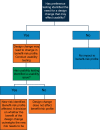Preference Testing in Medical Devices: Current Framework and Regulatory Gaps
- PMID: 35822064
- PMCID: PMC9271283
- DOI: 10.2147/MDER.S368420
Preference Testing in Medical Devices: Current Framework and Regulatory Gaps
Abstract
Preference testing is a valuable source of information that can be provided by both healthcare professionals (HCPs) and patients (users). It can be used to improve the design and development of medical devices by feeding into device usability and, ultimately, risk management. Furthermore, it can aid with selecting the most appropriate clinical endpoints to be used in the clinical evaluation of a device and increase patient engagement by incorporating patient-relevant outcomes. Preference testing is widely conducted in the food industry but is not widespread in the medical field due to limited guidelines and a lack of regulatory framework. As such, manufacturers may be unaware of the benefits of preference testing and fail to take full advantage of it, or conversely, may use inappropriate methodology and/or analyses and consequently fail to collect meaningful data. In this position paper, we aim to highlight the benefits and uses of preference testing, along with potential methods that could be used for preference testing of medical devices. A key step towards the wider implementation of preference testing in medical devices is for the publication of international standards and guidelines for the collection, assessment, and implementation of preference data into the life cycle of a medical device.
Keywords: PPI; medical device; patient preference; preference testing.
© 2022 Lewis et al.
Conflict of interest statement
Dr Amie Smirthwaite reports on working for a medical devices consultancy. The authors report no other conflicts of interest in this work.
Figures
Similar articles
-
The future of Cochrane Neonatal.Early Hum Dev. 2020 Nov;150:105191. doi: 10.1016/j.earlhumdev.2020.105191. Epub 2020 Sep 12. Early Hum Dev. 2020. PMID: 33036834
-
Integrating the Voice of the Patient Into the Medical Device Regulatory Process Using Patient Preference Information.Value Health. 2020 Mar;23(3):294-297. doi: 10.1016/j.jval.2019.12.005. Epub 2020 Feb 29. Value Health. 2020. PMID: 32197723
-
A Framework for Incorporating Patient Preferences Regarding Benefits and Risks into Regulatory Assessment of Medical Technologies.Value Health. 2016 Sep-Oct;19(6):746-750. doi: 10.1016/j.jval.2016.02.019. Value Health. 2016. PMID: 27712701
-
Next generation testing strategy for assessment of genomic damage: A conceptual framework and considerations.Environ Mol Mutagen. 2017 Jun;58(5):264-283. doi: 10.1002/em.22045. Epub 2016 Sep 21. Environ Mol Mutagen. 2017. PMID: 27650663 Review.
-
Computerized screening devices and performance assessment: development of a policy towards automation. International Academy of Cytology Task Force summary. Diagnostic Cytology Towards the 21st Century: An International Expert Conference and Tutorial.Acta Cytol. 1998 Jan-Feb;42(1):59-68. doi: 10.1159/000331535. Acta Cytol. 1998. PMID: 9479324 Review.
Cited by
-
The evolution of technical prerequisites and local boundary conditions for optimization of mitral valve interventions-Emphasis on skills development and institutional risk performance.Front Cardiovasc Med. 2023 Jul 21;10:1101337. doi: 10.3389/fcvm.2023.1101337. eCollection 2023. Front Cardiovasc Med. 2023. PMID: 37547244 Free PMC article. Review.
-
Patients with Growth-Related Disorders and Caregivers Prefer the Somapacitan Device to the Somatrogon Device: Results from a Randomized Crossover Study Assessing Device Preference and Ease of Use Following Simulated Injections.Med Devices (Auckl). 2024 Oct 30;17:427-439. doi: 10.2147/MDER.S484354. eCollection 2024. Med Devices (Auckl). 2024. PMID: 39493440 Free PMC article.
References
-
- E2943-15, A. Standard guide for two-sample acceptance and preference testing with consumers; 2021; Available from: https://www.astm.org/e2943-15r21.html. Accessed June 16, 2022.
-
- Hein K, Jaeger SR, Tom Carr B, et al. Comparison of five common acceptance and preference methods. Food Qual Prefer. 2008;19(7):651–661. doi:10.1016/j.foodqual.2008.06.001 - DOI
-
- FDA, Virtual ISPOR-FDA Summit 2020. Using patient preference information in medical device regulatory decisions: benefit-risk and beyond; 2020.
-
- Ellis BH. Acceptance and consumer preference testing. J Dairy Sci. 1969;52(6):823–831. doi:10.3168/jds.S0022-0302(69)86658-0 - DOI
-
- Zbrozek A, Hebert J, Gogates G, et al. validation of electronic systems to collect patient-reported outcome (PRO) data—recommendations for clinical trial teams: report of the ISPOR ePRO systems validation good research practices task force. Value Health. 2013;16(4):480–489. doi:10.1016/j.jval.2013.04.002 - DOI - PubMed
LinkOut - more resources
Full Text Sources
Research Materials




